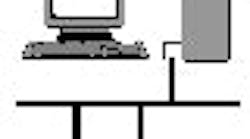If you’ve read this column over the past six months, I hope you’ve noticed how important the DCS configuration is to getting the most value from fieldbus.
When I first implemented control in field devices seven years ago, I quickly was impressed by the many thoughtful features that were elegantly woven into fieldbus blockware. I was poking around Blevins and McMillan’s Modeling and Control blog the other day, and came upon Terry’s post about the beginnings of fieldbus function blocks. Terry helped lead this effort and had at his disposal many of the most experienced and talented controls designers from across the industry. When one examines what’s built in to Foundation fieldbus (FF) control blocks, this comes as no surprise...
Just last month, I was troubleshooting a loop for our plant when I came across some code written in 1999 by a member of the original project team. In the two or three lines of code, the slave loop (a flow controller) was forced to local “AUTO” when the measurement (PV) of its cascade master (liquid level in a flash drum) was “bad quality.”
While it’s a diligent piece of work, this user-coded mode shedding is utterly unnecessary in fieldbus—it’s already hard-coded into the blockware and happens automatically. In the same way, the “actual” mode of a PID block sheds to manual when its PV status is bad or uncertain, holding the last output computed before the input’s signal status changed. (In the writer’s defense, we were all FF novices in those days.)
Rich Merritt, a former CONTROL editor, did an article for the September 2003 issue called “Want to Go Back?”, in which he polled users and suppliers about using “truly distributed” control, i.e., “control on the wire,” or “control in the field.” Merritt asked a bit tongue-in-cheek whether users really wanted to “go back” to 1940s single-loop integrity. A number of users who had no fieldbus experience and suppliers who didn’t support fieldbus were negative about control in the field.
Using fieldbus-based PID is a far cry from the technology available in the 1940s, 50s or even the 80s and 90s. Because signal status is so thoughtfully used and integrated by Foundation fieldbus control, we have a degree of robustness and fault-tolerance that not even the most bulletproof DCS of the 1990s could achieve. Kill power to your non-FF Coriolis meter or lift a wire on your HART-smart DP cell, and see what your valve does.
Even those who have written some clever code (as we once did) will likely see a bump to the process as the valve drives toward a limit. Those who have not could see the valve saturate full-open when its analog signal falls quickly to zero. Most legacy DCS and PLC systems don’t flag an analog signal “BAD” until it’s a few percent below 4 mA, so chances are your valve is considerably more open—if not pegged full-scale—before the system detects the fault.
Not so with Foundation fieldbus!
Bad or uncertain PV status will cause appropriate mode-shedding in the same scan (macro cycle) in which the condition is detected, so no “new” valve output is passed to the AO block; it dutifully holds last value. The output statuses are also used; once a “limited” status (i.e., valve at 100% or 0% open or at a user-defined limit) is passed to the PID from its valve positioner, both the inner loop and its “master” (if one exists) is alerted and controller windup is minimized.
All this happens by interconnecting the FF signals via your programming interface. No additional code or external interlocks are necessary. It’s built-in, out-of-the-box and standard in certified FF devices that have implemented PID.
Blevins’ crew was a pretty enlightened bunch, so users will find that all the “hooks” are there for remote cascade/remote out (supervisory control) and a menu of options for mode shedding. The contention that coordinated or multivariable schemes preclude fieldbus control is entirely false; we have several model predictive strategies that happily write set points and/or outputs to FF-based PID in the field.
Most systems now have excellent engineering tools and allow easy integration of fieldbus devices, so there are ever-fewer excuses not to try some “truly distributed control.” If you still have doubts, find a “safe” trial application, and see if you can break it. I think you’ll be impressed.
Please email me your comments and experiences!
| About the Author |

Leaders relevant to this article:





